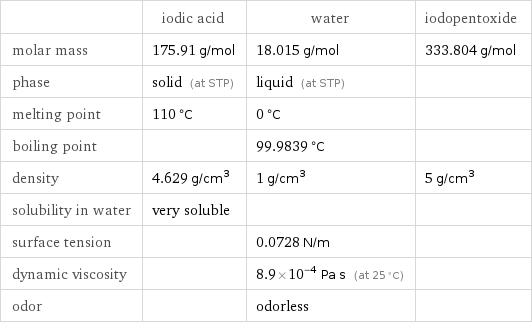Input interpretation

HIO_3 iodic acid ⟶ H_2O water + I_2O_5 iodopentoxide
Balanced equation

Balance the chemical equation algebraically: HIO_3 ⟶ H_2O + I_2O_5 Add stoichiometric coefficients, c_i, to the reactants and products: c_1 HIO_3 ⟶ c_2 H_2O + c_3 I_2O_5 Set the number of atoms in the reactants equal to the number of atoms in the products for H, I and O: H: | c_1 = 2 c_2 I: | c_1 = 2 c_3 O: | 3 c_1 = c_2 + 5 c_3 Since the coefficients are relative quantities and underdetermined, choose a coefficient to set arbitrarily. To keep the coefficients small, the arbitrary value is ordinarily one. For instance, set c_2 = 1 and solve the system of equations for the remaining coefficients: c_1 = 2 c_2 = 1 c_3 = 1 Substitute the coefficients into the chemical reaction to obtain the balanced equation: Answer: | | 2 HIO_3 ⟶ H_2O + I_2O_5
Structures

⟶ +
Names

iodic acid ⟶ water + iodopentoxide
Equilibrium constant
![K_c = ([H2O] [I2O5])/[HIO3]^2](../image_source/ac142bd179de957f6dea34b4d2a6be13.png)
K_c = ([H2O] [I2O5])/[HIO3]^2
Rate of reaction
![rate = -1/2 (Δ[HIO3])/(Δt) = (Δ[H2O])/(Δt) = (Δ[I2O5])/(Δt) (assuming constant volume and no accumulation of intermediates or side products)](../image_source/194d086726d5f8a73106f656f240cf8b.png)
rate = -1/2 (Δ[HIO3])/(Δt) = (Δ[H2O])/(Δt) = (Δ[I2O5])/(Δt) (assuming constant volume and no accumulation of intermediates or side products)
Chemical names and formulas

| iodic acid | water | iodopentoxide formula | HIO_3 | H_2O | I_2O_5 name | iodic acid | water | iodopentoxide IUPAC name | iodic acid | water | iodic acid iodyl ester
Substance properties

| iodic acid | water | iodopentoxide molar mass | 175.91 g/mol | 18.015 g/mol | 333.804 g/mol phase | solid (at STP) | liquid (at STP) | melting point | 110 °C | 0 °C | boiling point | | 99.9839 °C | density | 4.629 g/cm^3 | 1 g/cm^3 | 5 g/cm^3 solubility in water | very soluble | | surface tension | | 0.0728 N/m | dynamic viscosity | | 8.9×10^-4 Pa s (at 25 °C) | odor | | odorless |
Units
